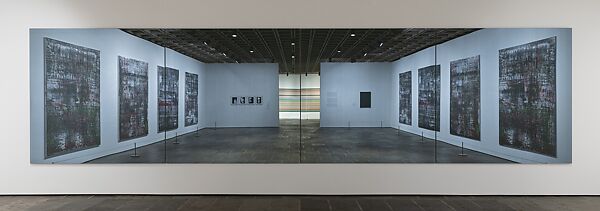
I cannot keep up. Literally the day I was contemplating even the possibility of a Facsimile Object of a Gerhard Richter Grey Mirror painting, Richter put four of them on permanent view. On his 92nd birthday. At Auschwitz.
Last month Gerhard Richter BIRKENAU, a permanent exhibition in a purpose-built pavilion, was opened at the International Youth Meeting Center in Oświęcim, the Polish town near the nazi death camp that took its name. It contains reproductions of the Sonderkommando photos that Richter used as a basis for the Birkenau series of large-scale squeegee paintings [CR 937/1-4] he made in 2014. [Two photos are visible on the concrete walls below.] It also includes full-scale Diasec-mounted versions of the Birkenau paintings [a medium Richter once used for a category he called “Facsimile Objects,” but which he later replaced with “Prints”]. And facing them are Facsimile Objects of a series of four Grey Mirror paintings. Photos of oil-on-glass paintings printed and Diasec face-mounted with acrylic on aluminum.

In this Guardian article [shoutout greg.org hero/reader Claudio for the heads up] Agata Pyzik tries to put a market–or at least a marketing—critique on Richter’s use of photo copies of paintings, even while acknowledging his attempts to remove his Birkenau works from an art market context. [Richter’s kept the paintings in his foundation, and put the other facsimile edition in the Reichstag.]

I read the Birkenau facsimiles, which he has shown alongside the Birkenau paintings from the jump, including at the Met Breuer in 2020, as an attempt to head off any sacralization of the paintings themselves. He did not make them to be, and he does not want them to become icons of the Holocaust. Even worse for him, I think, would be being seen as attempting to iconize or exploit these terrible photographs, to turn them to his own use. He sees limits to his own project of painting in relation to images and history, and he’s not wrong.

But while all the media attention is on the Birkenau pictures, the most unsettling and powerful element of the installation, the mirrors, barely gets a mention. If this were any other work, any other place, any other time, the fact that Richter made Facsimile Objects of mirror paintings would be enough to keep me going for weeks. These happen to be facsimiles of Grey Mirror [CR 751/1-4], a series of 3 x 1.75 m, color-coated glass paintings made in 1991 for—and by—the St Louis Art Museum, a gift with purchase. [The purchase was Betty.] In Oświęcim, Richter has turned them sideways, and installed them landscape-style, as one continuous 12-meter mirror panorama.
But these are there, and now.
And so visitors to Oświęcim, while flanked on either side by direct photographic evidence of the nazi genocide at Birkenau as documented by its targets, will see reflections of themselves and everyone else with their backs turned to a repetition of Birkenau which looms behind them. It’s at least theoretically possible, if previously inconceivable, that if he opened an exhibition in Germany that made visitors look in a mirror while turning away from the evidence of genocide all around them, Richter could be arrested.
[update: After corresponding with the artist’s studio about broken links on the webpage for this exhibition, I was informed that this mirror work is actually an “exhibition copy” of Grauer Spiegel (4 Parts) [CR955], and not [CR751/1-4]. Which means the dimensions and material aspect of this object are still to be confirmed. For now the artist’s site still describes them as Diasec-mounted prints. Is that whan an exhibition copy of a mirror work is? Or would it be a similarly produced enamel paint on the back of glass? Perhaps we shall see.

What is significant, though, and has been unremarked by anyone, is that with these mirrors, the BIRKENAU installation replicates the current long-term installation of the Birkenau paintings, the Birkenau photos, and Grauer Spiegel (4 Parts) [CR955], at the Neue Nationalgalerie in Berlin. So viewers in Germany can, in fact, see themselves in a mirror, with the genocide of Birkenau represented behind and all around them, know that this same situation exists somewhere else right now, and contemplate the differences between an original and a repetition.]
Inauguration of the Gerhard Richter BIRKENAU Exhibition Pavilion [mdsm.pl]
Painting the Unpaintable: Gerhard Richter’s most divisive work returns to Auschwitz [guardian via csant]
Previously, related:
2014: Cage Grid: Gerhard Richter and the Photo Copy
2023: Gerhard Richter Painted
2024: Grauer Richter Facsimile Object
